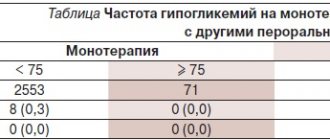Pharmacodynamics and pharmacokinetics
Pharmacodynamics
The Pharmacopoeia indicates that this drug improves the metabolism of cells of the nervous system. The structural formula of glutamic acid is C5H9NO4. A non-essential amino acid, present in the body only in the levorotatory form ( L glutamic acid a ). Acts as a mediator with pronounced metabolic activity in brain tissue, activates redox reactions in the brain, as well as protein metabolism. Regulates metabolism, transforming the functional status of the endocrine and nervous systems. Stimulates the transfer of excitation in neuronal synapses, promotes the neutralization and evacuation of ammonia , and increases resistance to hypoxia.
An important component of myofibrils , a component of the synthesis of other amino acids, ATP, acetylcholine, urea , helps transport and maintain the required content of potassium in brain tissue, serves as an intermediary between the metabolism of nucleic acids and carbohydrates, and normalizes the level of glycolysis in tissues. Has a hepatoprotective effect, suppresses the secretory function of stomach cells.
Pharmacokinetics
Has a high degree of absorption. It overcomes histohematic barriers, membranes of subcellular structures and cell membranes well. Accumulates in the liver, kidneys and soft tissues. Excreted in urine (5-7%) in its original form.
The role of glutamic acid in the body
Glutamic acid is responsible for activating metabolic processes occurring in the brain. It acts as a mediator of nerve impulses, increasing their activity. A sufficient amount of amino acid ensures stimulation of recovery processes in the brain, while simultaneously promoting protein metabolism.
Thanks to ongoing metabolic processes, the functions of the nervous system change and the functioning of the endocrine system is restored. At the same time, glutamic acid helps ensure the neutralization of ammonia and its removal from the body. The absence of glutamic acid deficiency increases resistance to hypoxia.
A person receives glutamic acid from the outside through food. In addition, it is synthesized by the body itself as a result of protein catabolism processes. The substance easily penetrates the blood-brain barrier, which prevents the passage of most drugs from the arterial bed to the brain tissue. The cell membrane is also not an insurmountable barrier to glutamic acid. It undergoes metabolic processes, and up to 7% of the incoming volume is excreted from the body by the kidneys. For progressive myopathy, an effective combination with glycine or pachycarpine has been identified.
Indications for use
Indications for the use of Glutamic acid (in complex therapy):
- inhibition of mental development of various etiologies, cerebral palsy , consequences after birth intracranial trauma, poliomyelitis , Down's disease ;
- schizophrenia, epilepsy (minor seizures), psychosis , depressive reactive state, insomnia , mental exhaustion , consequences of encephalitis and meningitis , progressive myopathy , depression ;
- neuropathy of toxic origin due to the use of isonicotinic acid derivatives.
Contraindications for use
Glutamic acid is not used in the treatment of patients with:
- hypersensitivity to glutamic acid;
- fever;
- stomach ulcer during exacerbation;
- anemia;
- problems of the hematopoietic system;
- nephrotic syndrome;
- increased nervous excitability.
If the prescription of the drug is a necessary measure, treatment should be carried out under constant monitoring of the patient’s condition. If adverse reactions occur, treatment is stopped.
Glutamic acid, instructions for use (Method and dosage)
The medicine is taken orally half an hour before meals; if symptoms of dyspepsia it is used after or during meals.
Adult patients are prescribed 1 gram of the drug up to three times a day.
- Children under 1 year of age are prescribed 100 mg per day.
- Up to 2 years of age, 150 mg per day is prescribed.
- Children 3-4 years old are prescribed 250 mg per day.
- Children 5-6 years old are prescribed 400 mg per day.
- Children 7-9 years old are prescribed 500-1000 mg per day.
- Children over 10 years of age are prescribed 1000 mg up to three times a day.
For oligophrenia, the drug is prescribed at the rate of 100-200 mg per kilogram of weight.
The duration of treatment is usually from 1-2 months to 1 year.
Buy Glutamic acid tablets p.o 250 mg No. 10 in pharmacies
Glutamic acid Buy Glutamic acid in pharmacies DOSAGE FORMS enteric-coated tablets 250mg film-coated tablets 250mg
MANUFACTURERS ICN October (Russia) Tatkhimpharmpreparaty (Russia)
GROUP Amino acids
COMPOSITION Active ingredient: Glutamic acid.
INTERNATIONAL NON-PROPENTED NAME Glutamic acid
SYNONYMS L-Glutamic acid, Glutamic acid, L-Glutamic acid
PHARMACOLOGICAL ACTION Neurotransmitter, stimulating metabolism in the central nervous system. Participates in protein and carbohydrate metabolism, stimulates oxidative processes, prevents a decrease in redox potential, and increases the body's resistance to hypoxia. Normalizes metabolism, changing the functional state of the nervous and endocrine systems. It is a neurotransmitter amino acid that stimulates the transmission of excitation in the synapses of the central nervous system. Participates in the synthesis of other amino acids, acetylcholine, ATP, promotes the transfer of potassium ions, improves the activity of skeletal muscles (it is one of the components of myofibrils). It has a detoxification effect, promotes the neutralization and removal of ammonia from the body. Normalizes glycolysis processes in tissues, has a hepatoprotective effect, and inhibits the secretory function of the stomach. When taken orally, it is well absorbed and penetrates the BBB and cell membranes.
INDICATIONS FOR USE Epilepsy (mainly minor seizures with equivalents), schizophrenia, psychoses (somatogenic, intoxication, involutional), reactive states occurring with symptoms of exhaustion, depression, consequences of meningitis and encephalitis, toxic neuropathy due to the use of isonicotinic acid hydrazides (in combination with thiamine and pyridoxine), hepatic coma. In pediatrics - mental retardation, cerebral palsy, consequences of intracranial birth injury, Down's disease, poliomyelitis (acute and recovery periods).
CONTRAINDICATIONS Hypersensitivity, fever, liver and/or kidney failure, nephrotic syndrome, peptic ulcer of the stomach and duodenum, diseases of the hematopoietic organs, anemia, leukopenia, increased excitability, violent mental reactions, obesity. Restrictions on use. Kidney and liver diseases.
SIDE EFFECTS Increased excitability, insomnia, abdominal pain, nausea, vomiting, diarrhea, allergic reactions, chills, short-term hyperthermia; with long-term use - anemia, leukopenia, irritation of the oral mucosa, cracks in the lips.
INTERACTION The effectiveness of use in combination with pachycarpine or glycine has been shown for progressive myopathy.
METHOD OF APPLICATION AND DOSAGE Orally, 15-30 minutes before meals. Adults and children 10 years and older - 1 g 2-3 times a day. Children: up to 1 year - 0.1 g, 1-3 years - 0.15 g, 3-4 years - 0.25 g, 5-6 years - 0.4 g, 7-9 years - 0.5-1 g, 2-3 times a day; for oligophrenia - 0.1-0.2 g/kg. The course of treatment is from 1-2 to 6-12 months.
OVERDOSE No data available.
SPECIAL INSTRUCTIONS During the treatment period, regular general clinical blood and urine tests are necessary. If side effects occur, stop taking and consult a doctor. After oral administration in powder or suspension form, it is recommended to rinse the mouth with a weak solution of sodium bicarbonate. If symptoms of dyspepsia develop, take during or after meals.
STORAGE CONDITIONS: Store in a cool, dry place.
Analogs
Level 4 ATX code matches:
Bravinton
Acefen
Carnicetine
Pyracesin
Nooclerin
Semax
Piracetam
Olatropil
Fezam
Vinpocetine
Cerebrocurin
Cavinton Forte
Calcium hopantenate
Cephabol
Olanzapine
Cerebrolysate
Pramistar
Sidnocarb
Vinpotropil
Glycine Ozone
Antifront, Armadin, Glycine, Instenon, Intellan, Cortexin, Neurotropin, Rilutek, Cytoflavin.
Reviews about Glutamic acid
Reviews of Glutamic acid show that the drug is used only in combination with more potent drugs and is more similar in action to dietary supplements. The evidence base for the benefits of the drug for this or that pathology is weak. Glutamic acid is used separately in sports and bodybuilding.
Glutamic acid in bodybuilding and sports
The drug is often included in the diet of athletes to increase performance. It helps to recover faster after intense physical exertion, as it reduces intoxication metabolic products and has a weak anabolic effect.
Indications for use of glutamic acid
Glutamic acid is primarily used to eliminate problems of the central nervous system. This drug is usually prescribed by neurologists for various abnormalities and diseases. Among which:
- Epilepsy, including petit mal seizures. Glutamic acid is used both in patients with congenital symptoms of epilepsy and in patients who acquired the disease as a result of necrosis of brain tissue caused by ischemic stroke. Such epilepsy can only manifest itself in the form of convulsive spasms of the muscles of the upper body.
- Schizophrenia, accompanied by hallucinations, insomnia, inability to concentrate on something, lack of interest in life.
- Psychoses of various types: both intoxicating and somatogenic.
- Depressive disorders.
- Brain damage as a result of meningitis or encephalitis.
- Hepatic coma.
- Acute poliomyelitis and the recovery period after it.
In pediatrics, glutamic acid is used as a means to help a child catch up with his peers in development. First of all, this concerns delayed speech development. In addition, the product is often used as an assistant in matters of adaptation when a child enters a new environment, in particular, begins to attend kindergarten.
After childbirth with complications, glutamic acid is also prescribed in order to minimize the outcome of intracranial birth trauma.
Glutamic acid price, where to buy
Buying 10 tablets of the drug in Russia will cost approximately 28 rubles.
The price of Glutamic acid in a pharmacy in Ukraine (the same release form) is 5-6 hryvnia.
- Online pharmacies in RussiaRussia
- Online pharmacies in UkraineUkraine
Pharmacy Dialogue
- Glutamic acid Vitamir (table 500 mg No. 30) Square C
99 rub. order
show more
Pharmacy24
- Glutamic acid No. 10 tablets PAT "Kiev Vitamin Plant", Kiev, Ukraine
7 UAH. order
special instructions
If the treatment is in powder form, it is necessary to rinse the mouth after each dose with a weak solution of sodium bicarbonate to reduce the acidity of the environment and protect the teeth from destruction.
Glutamic acid can be used as a treatment for various neurotoxic reactions that occur while taking other medications.
Taking the drug by children of preschool and school age should be accompanied by an accurate calculation of a single dose to avoid a possible overdose.

